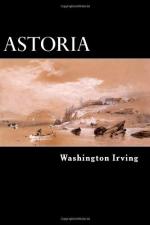The isolated rock in question presented a spectacle of the kind, numerous dead bodies being deposited in canoes on its summit; while on poles around were trophies, or, rather, funeral offerings of trinkets, garments, baskets of roots, and other articles for the use of the deceased. A reverential feeling protects these sacred spots from robbery or insult. The friends of the deceased, especially the women, repair here at sunrise and sunset for some time after his death, singing his funeral dirge, and uttering loud wailings and lamentations.
From the number of dead bodies in canoes observed upon this rock by the first explorers of the river, it received the name of Mount Coffin, which it continues to bear.
Beyond this rock they passed the mouth of a river on the right bank of the Columbia, which appeared to take its rise in a distant mountain covered with snow. The Indian name of this river was the Cowleskee. Some miles further on they came to the great Columbian Valley, so called by Lewis and Clarke. It is sixty miles in width, and extends far to the southeast between parallel ridges of mountains, which bound it on the east and west. Through the centre of this valley flowed a large and beautiful stream, called the Wallamot, which came wandering for several miles, through a yet unexplored wilderness. The sheltered situation of this immense valley had an obvious effect upon the climate. It was a region of great beauty and luxuriance, with lakes and pools, and green meadows shaded by noble groves. Various tribes were said to reside in this valley, and along the banks of the Wallamot.
About eight miles above the mouth of the Wallamot the little squadron arrived at Vancouver’s Point, so called in honor of that celebrated voyager by his lieutenant (Broughton) when he explored the river. This point is said to present one of the most beautiful scenes on the Columbia; a lovely meadow, with a silver sheet of limpid water in the center, enlivened by wild-fowl, a range of hills crowned by forests, while the prospect is closed by Mount Hood, a magnificent mountain rising into a lofty peak, and covered with snow; the ultimate landmark of the first explorers of the river.
Point Vancouver is about one hundred miles from Astoria. Here the reflux of the tide ceases to be perceptible. To this place vessels of two and three hundred tons burden may ascend. The party under the command of Mr. Stuart had been three or four days in reaching it, though we have forborne to notice their daily progress and nightly encampments.




